The Congregation of the Sisters of the Holy Cross (Menzingen) is Blessed with 175 Years of Service to Humanity – 17th Oct.2019
View(s): Background
Background
“It was the best of times, it was the worst of times, it was the age of wisdom, it was the age of foolishness, [..], it was the season of Light, it was the season of Darkness, it was the spring of hope, it was the winter of despair;” this extract from A Tale of Two Cities by Charles Dickens aptly fits the early 19th century Switzerland, that gave birth to the Congregation of the Sisters of the Holy Cross in a mountainous village called Menzingen on the 16th Oct.1844. It was a time in which different streams were crossing one another.
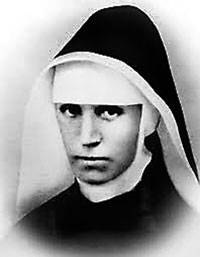 The cataclysmic changes that took place in 18th and early 19th centuries in the Continent created a disastrous effect in Switzerland. The French occupation in some parts of Switzerland, led to the formation of ‘Student Association,’ establishment of ‘Rifle Association’ and the ‘shooting feasts’ were held sporadically. There were conflicts between Radicals and Conservatives; Protestants and Catholics; State and Church were at locker head with each other; Bismarck’s activities in Germany led to the confiscation of papal properties in Italy, which supported the Radicals’ activities in Switzerland to work against Christianity. Industrial Revolution that was changing the face of England had an adverse effect in the country. Children of 5 years were employed for 5 hours a day in the factories; the boys and girls between the ages of 11 to 20 yrs. were subjected to work for eleven and a half hour night shift and thirteen hour day shift. Since the money was freely in the hands of children of 6 yrs. and above, they, like their elders were smoking, swearing, quarrelling; moral decadence was glaringly noted. Switzerland was a ‘waste land’ at that time.
The cataclysmic changes that took place in 18th and early 19th centuries in the Continent created a disastrous effect in Switzerland. The French occupation in some parts of Switzerland, led to the formation of ‘Student Association,’ establishment of ‘Rifle Association’ and the ‘shooting feasts’ were held sporadically. There were conflicts between Radicals and Conservatives; Protestants and Catholics; State and Church were at locker head with each other; Bismarck’s activities in Germany led to the confiscation of papal properties in Italy, which supported the Radicals’ activities in Switzerland to work against Christianity. Industrial Revolution that was changing the face of England had an adverse effect in the country. Children of 5 years were employed for 5 hours a day in the factories; the boys and girls between the ages of 11 to 20 yrs. were subjected to work for eleven and a half hour night shift and thirteen hour day shift. Since the money was freely in the hands of children of 6 yrs. and above, they, like their elders were smoking, swearing, quarrelling; moral decadence was glaringly noted. Switzerland was a ‘waste land’ at that time.
The ‘Waste Land’ becomes the fertile ground for birthing the Congregation.
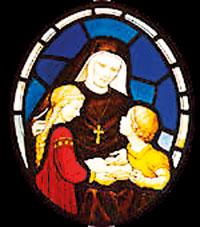 On the one hand, while this period of ‘foolishness’, ‘darkness’ and ‘despair’, created the “Waste Land” and on the other, the age of ‘wisdom’, ‘hope’, ‘belief’ and ‘light’ formed a fertile ground for a new Religious Order to spring forth in answer to the needs of the time, namely Religious Freedom, Moral betterment, and Intellectual and Spiritual formation of youth by means of wholesome Education. During the 18th century the church authority was very powerful. A complex situation was developing in Switzerland. Religion and politics interlaced. During the 19th century science was developing. Science had challenged the old order of living the Christian way of life and values. The state had taken complete control over all schools and the Church had no say. Anna Maria Heimgartner (born on 26th11,1822), Anna Krammar, and Wulberghe Mader came to be aware of all what was taking place in their country and in the continent, decided to become Religious. The main bone of contention between the government and the Catholic Church in Switzerland was the control of the education system and the independence of the Catholic Church. Fr.Theodosius Florentini, (Fr.Theo) a Franciscan Monk who was well known as a social reformer and as an educationist in the 19th century Switzerland, dreamt of founding a Religious order that will not only answer the needs of that time but also would fit in anywhere at any time. Fr.Theo knowing these three girls’ desire sent them to Germany, and France for both professional and religious training for three years. The three Novices although tempted to join the settled comfortable Teaching Order in Riburville Sisters, chose the difficult path, to begin a new form of Religious order in their mother land, where all were not rosy for them. The State had already closed many Convents and monasteries and no new Religious orders were allowed to come into existence. It was a time of transition, a time when you had to quickly think anew under pressure. The old was leaving and the new was not yet in place. In this time of great complexity the three on their return made the religious vows in Altdorf on 16th Oct.1844, taking their names as Bernarda Heimgartner, Feliciana Krammer, and Cornelia Mader. Fr.Theo who prepared them well to face the contextual realities, on sending them to their first mission to Menzingen as teachers, advised them “find your convent in the world, and find your silent room (chapel ) in your heart” which in today’s parlance is ‘contemplation in action’.
On the one hand, while this period of ‘foolishness’, ‘darkness’ and ‘despair’, created the “Waste Land” and on the other, the age of ‘wisdom’, ‘hope’, ‘belief’ and ‘light’ formed a fertile ground for a new Religious Order to spring forth in answer to the needs of the time, namely Religious Freedom, Moral betterment, and Intellectual and Spiritual formation of youth by means of wholesome Education. During the 18th century the church authority was very powerful. A complex situation was developing in Switzerland. Religion and politics interlaced. During the 19th century science was developing. Science had challenged the old order of living the Christian way of life and values. The state had taken complete control over all schools and the Church had no say. Anna Maria Heimgartner (born on 26th11,1822), Anna Krammar, and Wulberghe Mader came to be aware of all what was taking place in their country and in the continent, decided to become Religious. The main bone of contention between the government and the Catholic Church in Switzerland was the control of the education system and the independence of the Catholic Church. Fr.Theodosius Florentini, (Fr.Theo) a Franciscan Monk who was well known as a social reformer and as an educationist in the 19th century Switzerland, dreamt of founding a Religious order that will not only answer the needs of that time but also would fit in anywhere at any time. Fr.Theo knowing these three girls’ desire sent them to Germany, and France for both professional and religious training for three years. The three Novices although tempted to join the settled comfortable Teaching Order in Riburville Sisters, chose the difficult path, to begin a new form of Religious order in their mother land, where all were not rosy for them. The State had already closed many Convents and monasteries and no new Religious orders were allowed to come into existence. It was a time of transition, a time when you had to quickly think anew under pressure. The old was leaving and the new was not yet in place. In this time of great complexity the three on their return made the religious vows in Altdorf on 16th Oct.1844, taking their names as Bernarda Heimgartner, Feliciana Krammer, and Cornelia Mader. Fr.Theo who prepared them well to face the contextual realities, on sending them to their first mission to Menzingen as teachers, advised them “find your convent in the world, and find your silent room (chapel ) in your heart” which in today’s parlance is ‘contemplation in action’.
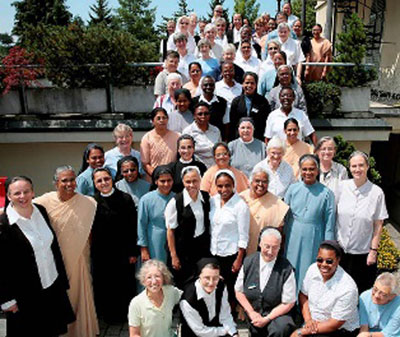
The young girls, who received the new form of education from these sisters prepared themselves, for their roles in the future on partnership model, to be on an equal level with their husbands. Such transformation brought about by education falls in line with what Mary Wollstonecraft had to say “women in common with men, are placed on this earth’.
Faithfulness to the founding purpose amidst conflicts and confusion
“Like sheaves of corn love gathers you unto himself.
He threshes you to make you naked.
He sifts you to free you from your husks.
He grinds you to whiteness.
He kneads you until you are pliant; and then he assigns you to his sacred fire, that you may become sacred bread for God’s sacred feast…” (Kahlil Gibran)
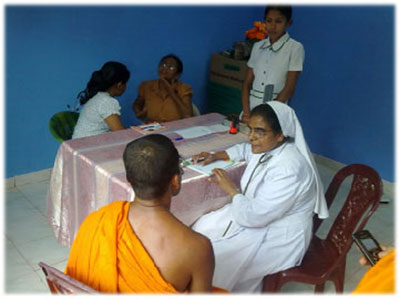
In 1855, within 10 years of coming into existence, the congregation was engaged in 30 Primary State Schools (State had already recognized their efficient teaching and excellent knowledge) 4 Private High Schools and one Teacher Training College; the sisters were named as Sisters of the Holy Cross (Menzingen). They administered all schools, guided by the great educationist Fr.Theodo who planned all curricula and all logistics that went into that holistic education. He was happy on the transformation that was taking place in the society, which he once vowed to bring in, by using the same weapon that the State used against the Church – the Education of Youth.
Within a gap of three years of coming into existence, there came in conflict and confusion between the Congregation and the male hierarchy connected to the Congregation. Fr.Theo was transferred to Canton Chur, his superior forbidding him to have any connection with the newly found Congregation was a shocking surprise to the newly found congregation. The sisters had to take responsibility for all their endeavour. The Holy Cross Sisters made their vows to live the vowed life and carry out their ministry according to the Constitutions approved by the Ecclesiastical Superior. The purpose of the Congregation was the formation of youth through holistic education. When the founder began to answer the other social needs like taking care of the endangered youth, orphans, and work house children and taking care of the sick and so on in Canton Chur , MBH generously gave her teaching sisters to answer those needs. And these sisters were named by him as Sisters of Mercy. Gradually the founder wanted more and more sisters. MBH found herself in an ambiguous situation. On one side Fr.Theo is her benefactor and the Founder and on the other side, the sisters who had over worked were dying young, of tuberculosis as well as there was confusion and conflict created between the school administration and herself as the principle for not replacing trained sisters in place of the sisters who were removed.
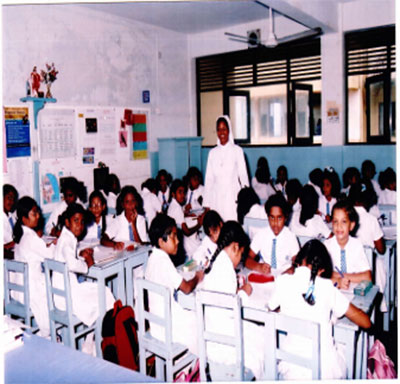
When the efforts were taken by the Founder to amalgamate both Congregations and transfer the Mother House from Menzingen to his Canton, the Ecclesiastical authority halted this change in answer to the request of MBH as she was of the firm, as well as committed to the original purpose that of formation of young girls through holistic education. She took up this stance in order to keep her promise to the Lord, care for her sisters as well as to keep her commitment to the education of youth. MBH knew in her heart that it is the Church that gave her a status as a Religious, educationist, and Superior General. Yet it is the Church that crushed her conscience. Not very long, another move was taken by Abbot Birker to change the Congregation into Monastic order –all time praying. And still another priest wanted to change the constitutions and the mode of life of these sisters. DiarmuidO’Murchu, a great writer and a Social Psychologist opines that Patriarchal culture is formidably present in all major religions:
“Patriarchal culture tend to breed a climate of codependency. Some are in charge and others are subservient, and to keep the majority in a passive ‘obedient’ role, a rhetoric of parenting predictably arises. We see this in every major religious culture- because all formal religion is heavily influenced by the reign of patriarchy”. (P.37)
The Patriarchal power of the male hierarchy could be seen in the letter written to the Bishop of Basle (23.8.1856). “I will call this institute up to this very day, my institute”. “I wanted to be the centre, the very life and soul of it all”. Has there been any Institutes or the Congregations considered to be the property of an individual? Don’t the Congregations exist for the Church?
MBH lived in the period of Enlightenment. Kant’s Motto of ‘Enlightenment’ “Have courage to use your own understanding” aptly coincided her action. MBH “cultivated” her mind and “succeeded in freeing herself from immaturity and continued boldly her way.”
She held fast to the original purpose of the Congregation stated in the Constitutions, which describes the special purpose of the Institute thus: “the training and strengthening of the powers of body and mind and good breeding and manners and teaching of the female youth…” The male hierarchy was exacerbated and what they could do was to intensely demonstrate their patriarchy power towards the sisters. She had been “threshed”, “sifted,”, “grounded,” “kneaded” and “assigned to the sacred fire so that she became the sacred bread for God’s feast”. Anyone who “establishes prerogatives of males has not understood Jesus as the liberator of all people, men and women, and has not understood the way He liberated us” so says Bernard Haring.
A period of storm and hurricane, painful and humiliating experiences but the sisters went through this, fortified by the Spirit and Crucified Resurrected Lord. Spirituality springs forth only through living experiences lived in deep Faith in the Lord, and not merely in the ideas and plans laid down.
Biblical Women
MBH perhaps followed the way of some of the Biblical women found both in the Old and in the New Testaments. There are many Biblical women, who had tried to assert their equality to the male dominators. For example, Deborah(Judges 4-5) was a prophetess, poetess, a leader and a worrier. Queen Vashti (Esther 1/11) refused to obey the king’s order to be present before the king and his drunken men.
Mary Magdalene was a visionary, a leader and a courageous woman (John 9/25) who transformed the gender roles, by standing by Jesus during his passion and death. MBH was one of them in the early 19th century. Mother Bernard as a ‘woman religious’ of her time through her firm resistance and struggles against the dominant hierarchy, that were hell bent on subjugating women and their efforts to maintain their dignity as women had successfully brought life to her daughters as well as to the young girls of Menzingen.
If not for her grit and fidelity to the original purpose of the Congregation, as well as her commitment, trust in the Lord and openness to the contextual realities, the life of the Congregation would have been stifled within three years of its existence.
The Congregation that kept the life force spread globally. But the wonder of it is when she died at the age of forty as the victim of cancer, Fr. Businger writes “In this excellent woman I met an ideal person, uniting feminine greatness of soul, prudence, inflexible fortitude with childlike piety. I thank God for allowing me to be in such close contact with this ideal character for almost ten years” ( Schonenberg p.61)
She was all modest and humble, yet intelligently and prudently expressed her views to the Founder, Bishop, Fr.Rollin and, Abbot Birker and others. When Abbot Birker in 1861, was hard on MB. Fr. Theo himself said to Dean Rutinan “No sister would be able to fill the place of MB who is very intelligent, possessed the third eye of prudence and filled with Faith”.
Both MBH and Fr.Theo had deeply understood each other. Even after the separation of both institutes, the Founder as well as MB had been visiting each other and sisters in order to receive guidance as well as share fatherly sisterly care.
Let there not be any notion that MBH was a feminist. MBH was NOT a feminist in the sense of the word used towards the end of 20th century, and could not have been a feminist as a contemporary of the 19th century, and a daughter of the Roman Catholic Church of that period.
“She was doubly conditioned in her understanding of womanhood; in a free and natural way she interiorized the value system in relation to the role and the task of a ‘woman’. MBH appears though more forced by circumstances than by her own choice –pioneering a ‘New Image’of a ‘woman religious’ which could only impact on society and in the Church a century after her death. ” so says Sr.Finbarr Coffey in her doctoral thesis.
Global Expansion
Touched by the selfless and the fruitful service rendered by the Holy Cross sisters, different countries invited the Congregation to serve their people. Sisters willingly accepted the invitations without any fear of cultural changes and language barriers they would face, but moved forward as ‘SOWERS of HOPE’ and set their feet in Africa – Mthatha in 1883; Germany in 1896;South America –Rio Bieno in1901; Chile in 1930; Peru 2002; Italy in 1888; England 1902; Ireland 1930; Argentina in 1953; India-Trivandrum in 1906; Sri Lanka 1930; Cape in 1937; Lesotho in 1907;; Zambia 1936; Namibia 1922; Zimbabwe 1956;Central Indian and North Indian Province in 1967.The missionary pioneers braved all challenges, for example, the first five sisters arrived in Durban –South Africa, had to travel a long exhausting journey in land by ox-wagon and arrived Umthatha (Mthatha)at midnight on 24th July1883.
Here the Holy Cross sisters moved into three small huts which became their first convent. So were all other beginnings in other countries. One thing was noted that in all countries, priority was given to the original purpose of the Congregation namely, “Formation of youth through holistic education” except in India and in Sri Lanka, where the sisters turned out to be nurses, answering the local needs of that time namely, taking care of the sick. However, keeping to the changes taking place globally, with embedded resilience and mobility, the sisters thrust themselves to reach out for the new; as such many are the activities on socio-cultural religious –health and economic levels according to the needs of the situation, besides education of youth up to the level of high schools, were taken over by the sisters wherever they were.
Foot Prints in Sri Lanka
On 26th August 1930 Srs. Benedicta Stoker, Othma Krunter, and Maria Carola set their feet in the Island of Kayts, and began their service to the suffering humanity in Kayts base hospital, and at the repeated requests made by people as well as the higher authority, seven sisters were sent to Jaffna Government Hospital, where they assumed duties as nurses And Rev. Mother Aloisia Roosli, who was the first Provincial of the Sri Lankan Province, functioned as the Matron and administrator of the section. Unfortunately, in 1963 the then government not only terminated all Religious sisters from working in hospitals, but also all missionaries were made to leave the Island within the stipulated days.
Thus twenty five years of dedicated and committed service by the sisters to the care of the sick in government hospitals came to an end.
Sisters with their creativity and newness of life faced the new challenges, and attained new insights. Consequently ministering activities varied; like teaching from Nursery to University level, social-developmental activities, the Nursing care rendered in 4 different Nursing homes, two Health Centers in Jaffna and in Paranthan, two Homes for the aged in Colombogam, and Trincomale and Pastoral ministry all aimed at the service of suffering humanity.
They conceived new possibilities which resulted in multiple projects with the view of bringing solace to the poor, the war stricken widows, rehabilitation of drug addicts, youth counselling, and estate apostolate and so on.
Through all these ministries, sisters as healers touched the families’ lives. Today the sisters work in seven dioceses in Sri Lanka. It is no wonder, because of the sisters’ flexibility and mobility, as time kept changing, as new challenges, new expectations, and new needs came thrashing down, the sister as SOWERS of HOPE kept abreast with them updating their knowledge and commitment to God and service to His children according to the needs of the time. The Congregation that has travelled up the hill and down the valley throughout this hundred and seventy five years, has been always engaged joyfully at the service of humanity, rejoices today, with Mary our Mother:
“My soul doth magnify the Lord, for He has done marvelous things to me. “Ad Multos Annos”.
Sr.Concelia Mariampillai H.C


